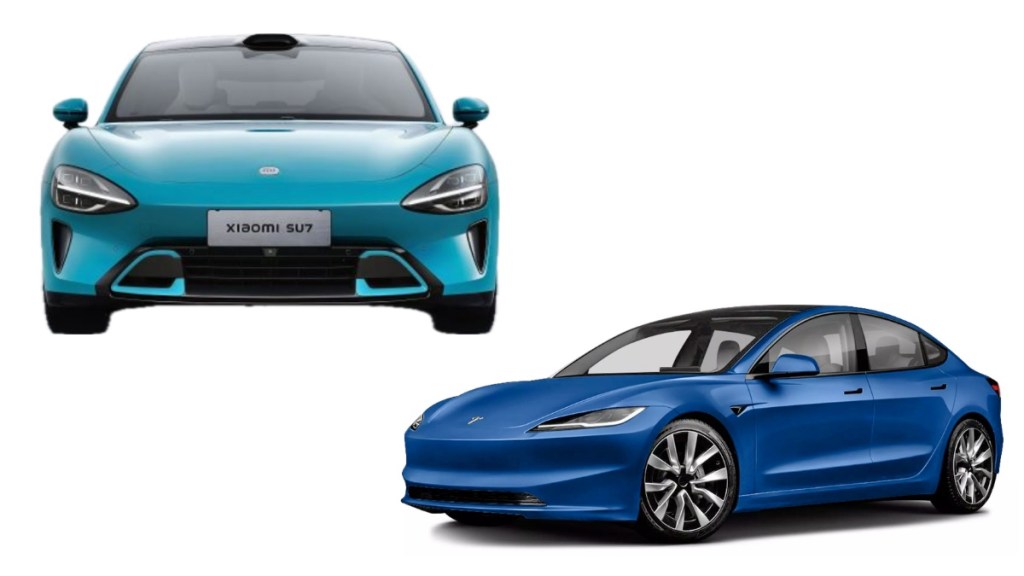With the release of the SU7, Xiaomi has fired the opening shot in the realm of electric cars. Given that China is the largest EV market in the world, the electronic giant is aiming to disrupt the ecosystem by taking on well-known companies like Tesla. We all know that Tesla is planning to set up shop in India, even though Xiaomi has not disclosed any plans to deliver the SU7 here. We compare the entry-level Model 3 versus the tech brand’s new EV.
Tesla Model 3 vs Xiaomi SU7: Dimensions
The teardrop is by nature the most aerodynamic shape. This explains why the designs of cars with the lowest drag coefficients (Cd) flow like water and lack sharp edges. Electric vehicles have a curved external style because they perform better and are more efficient.
The Xiaomi SU7 appears to be a new product from Porsche. As a result, it sports a drag coefficient of 0.195, exquisite contours, and an amazing low-road stance. The Chinese business claims that it has the lowest drag coefficient on the planet. Additionally, a sleek LED tailboard light bar and an active rear spoiler give the rear design an Aston Martin-like appearance.
The Tesla Model 3 is one of the best-selling electric vehicles in China. It has a drag coefficient of 0.23 Cd. In terms of dimensions, the Model 3 is shorter than the Xiaomi EV.
| Dimensions | Xiaomi SU7 | Tesla Model 3 |
| Length | 4,997 mm | 4,719 mm |
| Width | 1,963 mm | 2,087 mm |
| Height | 1,445 mm | 1,440 mm |
| Wheelbase | 3,000 mm | 2,875 mm |
Tesla Model 3 vs Xiaomi SU7: Performance and Range
The Xiaomi SU7 comes in three different versions: Standard, Pro, and Max. The Max is built on an 800V design, whereas the other two trims are based on a 400V architecture. The Standard has one electric motor and is powered by a 73.6 kWh BYD Blade battery with a 295 horsepower output. Its top speed is 210 kmph, and it can go from 0 to 100 kmph in 5.28 seconds. Its range is 700 kilometres, according to Xiaomi (CLTC). The EV can be charged to 350 km in 15 minutes using a fast charger.
The mid-range Pro variant gets a bigger 94.3kWh battery. This ensures that the Pro offers a longer 830 driving range (CLTC). It does 0 to 100 kmph in 5.7 seconds but the top speed remains the same as the Standard at 210 kmph. It also manages to top up 350 km range in 15 minutes of charge.
All conquering SU7 Max comes with a 101 kWh battery and has an AWD system. It has an output of 664bhp and does 0-100 kmph in 2.78 seconds with a top speed of 265 kmph. According to Xiaomi, the Max has a range of 800 km (CLTC) and offers 510 km of range with only 15 minutes of charge.
There are two versions of the Tesla Model 3 available: RWD and Long Range. Let’s begin with the RWD, which is entry-level. The base model has an EPA estimated range of 437 km and is powered by a 50 kWh battery. Even though Tesla does not formally reveal the power figures, reports indicate that the entry-level model has about 260 horsepower. At 0 to 100 km/h, it takes 5.8 seconds. Just 15 minutes of charging can provide a 282 km range for the basic Model 3.
The Long Range, on the other hand, gets an 82 kWh battery pack with a range of 549 km. It has an all-wheel-drive system and comes with dual electric motors on each axle. The front motor has an estimated power output of 184bhp and 260bhp for the rear. According to Tesla, the Long Range does 0-100 kmph in 4.2 seconds. Like the standard version, the Long Range also offers a range of 282 km in 15 minutes charge time.
